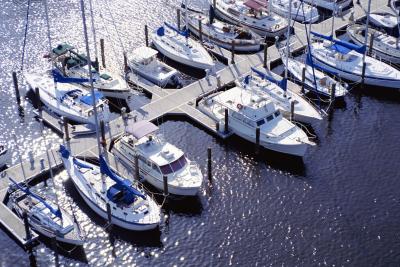
Frozen or seized motors on marine craft have serious consequences, and the type of seizure or the reasons for it could involve many factors. Marine motors that have not been properly winterized for storage can result from lack of fogging and lubrication to the piston rings or valve stems. Other reasons could be a spun or damaged rod or cracked bearings, which pose a more serious threat. Boat owners who experience frozen marine motors must use some special products and tools to free their motors. The procedure is timely, and delicate steps must be used for success.
Place the outboard motor in neutral and disconnect the negative battery cable from the terminal with a socket. Pull the quick release connector on the fuel supply line to the carburetor. Use an end wrench to remove any wires connecting the interior of the boat to the motor, such as the dash panel and ignition electrical harness connectors. Unsnap the top motor cowl and set it aside.
Remove the engine oil filler cap and check the level. Fill the reservoir to the prescribed maximum allowed limit with marine motor oil. Use a socket and wrench to remove or loosen the jack plate motor mount bolts and nuts, or manually unscrew the motor mount clamps. Have an assistant help you lift the motor and place it upright on a furniture dolly. Tape the motor in place with duct tape, securely wrapping it around the motor and dolly frame. Transport the motor to a garage or sheltered work space.
Use a socket to remove the pull start mechanism. There should be three bolts that hold the brackets to the engine. This will allow access to the main crankshaft pulley nut. Use a socket to remove the spark plugs, or multiple plugs for two or more cylinders. Position the engine on the floor in such a way that the piston and spark plug holes are at the top. Fill a disposable turkey baster with penetrating oil and attach a plastic tube to the end of the baster tip.
Insert 1/2 ounce of penetrating oil into each cylinder and agitate the motor back and forth, up and down. Add 1/2 ounce of penetrating oil to each cylinder, once in the morning and once in the evening, for three or four days. This will allow a complete soak and a chance for the oil to penetrate past the rings. Without adding any more oil, let the motor sit an additional three to four days for a total week of soaking.
Place a socket with a breaker bar over the crankshaft nut and strike the bar with the heel of your hand several times, alternating from clockwise to counterclockwise. If it frees up and turns, stop and add 1/2 ounce of penetrating oil to each cylinder. Remove the valve cover, or covers, with a socket. Stick the baster tube between the valve springs on each cylinder and wet the valve stems thoroughly. Turn the motor on its side if you need to let the oil travel down the valve stem into the cylinder head. This lubricates and frees the valve guides.
Strike the top of the valve springs several times with a plastic mallet. Add another dose of oil to each valve stem with the baster. Use an impact wrench on the crankshaft nut, first turning the wrench in a clockwise direction, then reversing the rotation. Do this with a low-pressure setting on the impact wrench. If the motor moves significantly, stop and add another 1/2 once of penetrating oil to each cylinder. Use the breaker bar and a socket to turn the crankshaft several rotations, until you feel no turning resistance.
Replace the starter pull mechanism and tighten the mounting bolts with a socket. Put rags over the spark plug holes and pull the start rope at least a dozen times to blow out the residue oil from the cylinders. Install the spark plugs with a socket. Replace the valve covers and tighten them in place with a socket. Transport the engine to the boat and remove all of duct tape. Have your assistant help you lift the engine into place. Insert the jack plate mounting bolts and tighten them with a socket, or tighten the engine clamps by hand.
Hook up the fuel line quick release, then reconnect the electrical harness. Reconnect the negative battery cable.